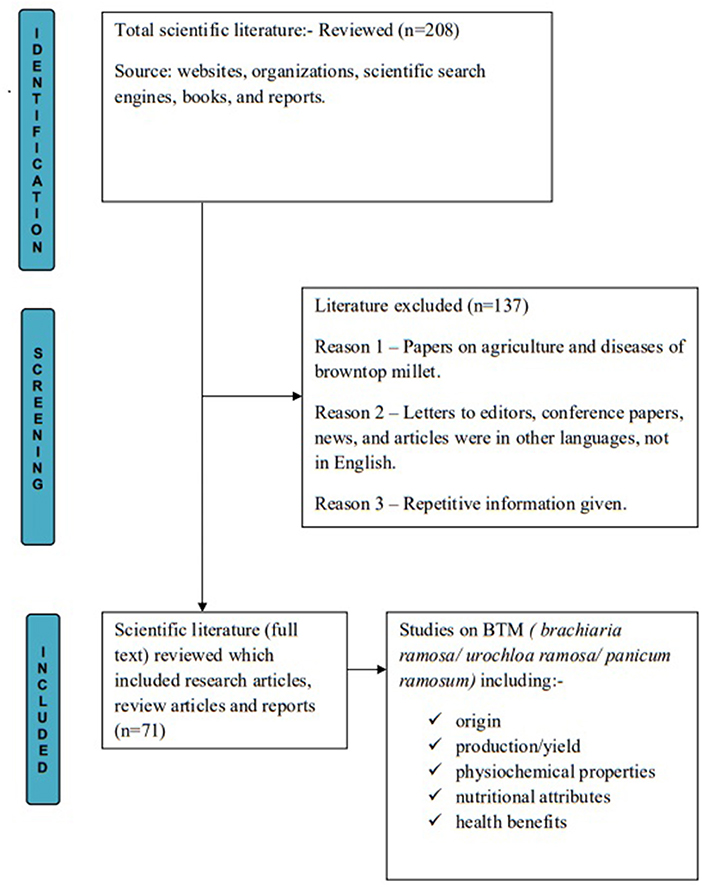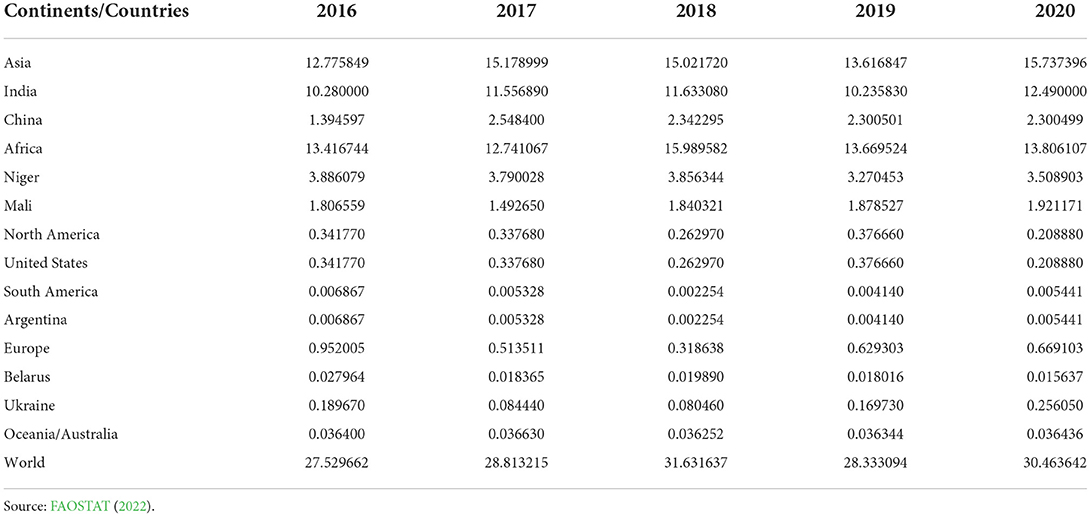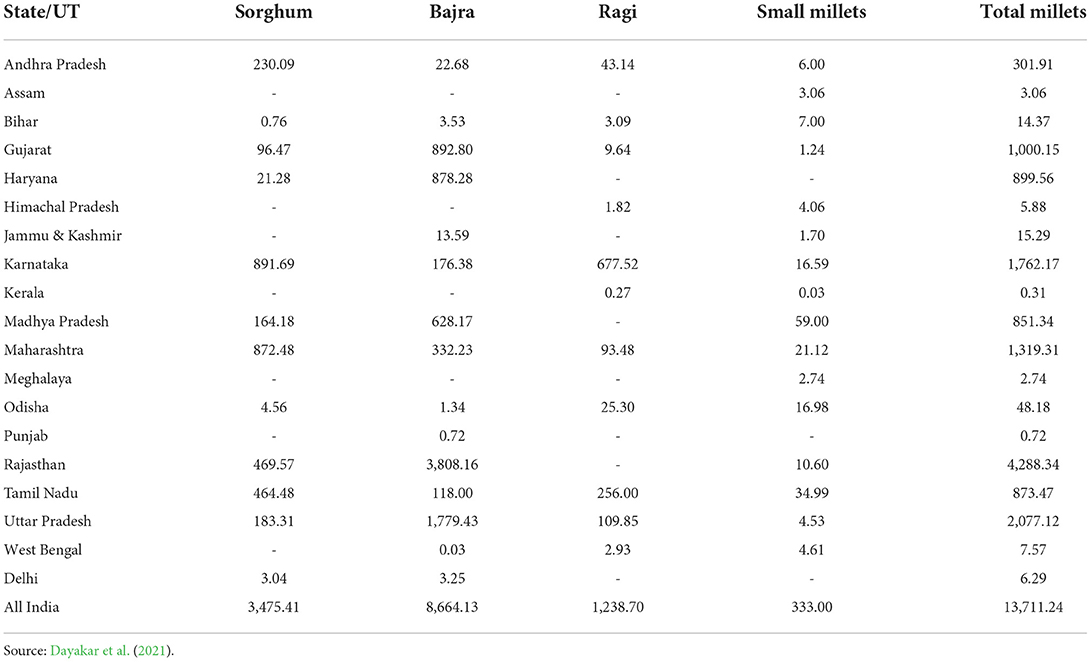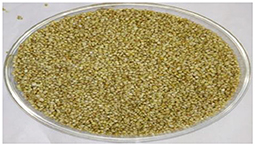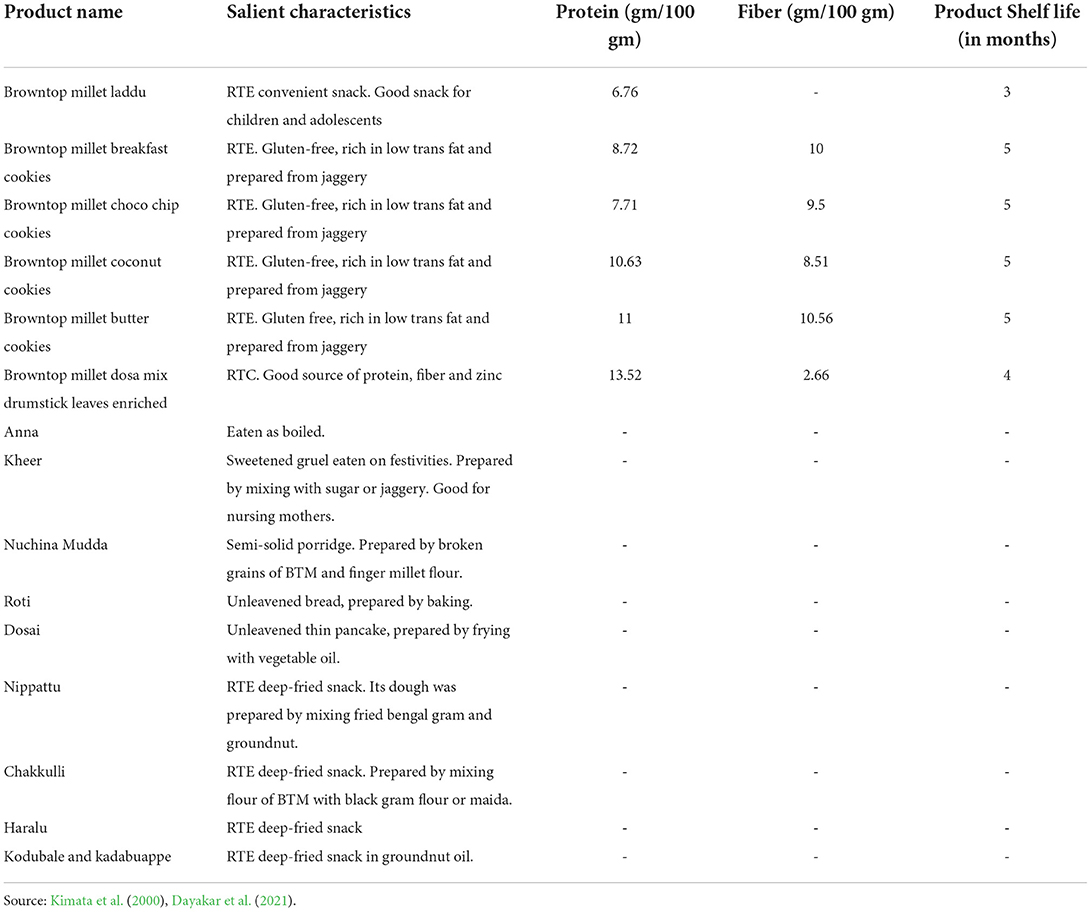- 1Department of Home Science (Foods and Nutrition), University of Delhi, New Delhi, India
- 2Department of Food Technology, Vivekananda College, University of Delhi, New Delhi, India
- 3Department of Food Technology, Shaheed Rajguru College of Applied Science, University of Delhi, New Delhi, India
Browntop millet (BTM) is small-seeded annual grass cultivated as grain crop, primarily on the marginal lands in dry areas in temperate, subtropical and tropical regions. It is increasingly receiving attention of the scientific community. Aim of this systematic review is to study the physiochemical, sensory, functional and nutritional properties as well as health benefits of browntop millet. This paper is based on quantitative and qualitative secondary data obtained from 71 out of 208 descriptive and scientific literature reviewed and analyzed from the national and international electronic platforms. The scientific literature based on browntop millet has been found scanty. According to the few studies available energy ranges from 338.0 kcal to 368.62 kcal. The carbohydrate, crude fiber and fat content of BTM is 71.32 gm, 8.06–16.08%, 1.89 gm, respectively. Protein is between 11.64% and 10.72%. Browntop millet contains phytochemicals such as flavonoids, quinones, tannins, and resin. There is galore scope for development and standardization of value added products made from browntop millets such as ready to eat foods (cookies, bars, deserts, etc) and ready to cook foods (idli mix, poha, etc) in which the millet can be used in combination with other cereal grains. Thus, browntop millet holds great potential in alleviating food and nutrition insecurity. It has good nutritional value. It can be used for the prevention and management of several non-communicable diseases. In order to make this smart food popular among farmers and consumers, systematized studies in the field of agriculture, nutrition, toxicology, naturopathy and biomedical sciences need to be done and documented properly. From ancient times BTM has been used in many forms such as forage, staple food or in many traditional dishes. An e-repository can be made of the traditional Indian foods made from BTM to popularize its use among the younger generations.
Introduction
Millets are small-seeded annual grasses belonging to Poaceae family. They are cultivated as grain crops, primarily on marginal lands in dry areas in temperate, subtropical and tropical regions. These crops have many advantages in terms of ability to thrive and give good yield even under adverse conditions (Gomashe, 2017). Being good source of fiber, polyphenols and other biological active compounds, they are also considered to play an important role in lowering the rate of fat absorption, retarding the release of sugars (low glycemic index) and thus reducing risk of several non-communicable diseases such as heart disease, diabetes and high blood pressure (Kumar et al., 2018). Amongst various small millets, the importance of browntop millet (BTM) (Urochloa ramosa; Panicum ramosum L.; Brachiaria ramosa L. Stapf) has been recognized recently as it has huge potential to give high yield in resource-poor and fragile ecological conditions and thus can ensure economic and nutrition security as well as sustainability in production of small farm holders (Maitra, 2020). As per the Gazette no. 133 issued by Government of India (GoI) in 2018, millets have received the much needed attention. However, BTM is yet to receive recognition in the gazette. Millets are considered to be smart foods (International Crop Research Institute for the Semi-Arid Tropics (ICRISAT), 2022). Indian Institute of Millet Research is currently working on BTM (Madhusudhana et al., 2021). Therefore, the present study was planned to address various questions such as:
• Origin and yield of BTM.
• Physiochemical, nutritional and sensory properties of BTM.
• Comparison of BTM nutritional properties to other major and minor millets available in India.
• Food and non-food uses of BTM.
• Health benefits of BTM.
• Future scope of research work on BTM.
Methods
Types of outcome measures
Studies (including secondary data) reporting origins of BTM, yield, physiochemical, sensory, functional and nutritional properties of BTM and its health benefits were considered and included while reviewing scientific literature.
Types of study
Review articles, research articles and reports.
Source of data
Reference books and electronic search engines like Google scholar, research gate, Pubmed and CERA J-gate which provided published research/ review articles in indexed journals about the BTM—origin, uses in different regions of India, physiochemical, sensory, functional and nutritional properties, health benefits of BTM, as well as websites of relevant organizations were referred for this study.
Search methods
A thorough review of scientific literature was done using the keywords “millet”, “browntop millet”, “brachiaria ramosa”, “urochloa ramosa”, “panicum ramosum”, “health benefits”, “nutrition”, “physical properties”, “nutritional value”, “browntop millet origin”, “production”, etc. The policy documents and scientific literature available on websites of Government of India (GoI), Indian Institute of Millets Research (IIMR), Indian Agriculture Research Institute (IARI), Ministry of Agriculture & Farmers Welfare (MoAFW), International Crops Research Institute for the Semi-Arid Tropics (ICRISAT), etc., were reviewed thoroughly. The search was limited to literature published from 1984 to 2022.
Selection criteria and analysis
As per the inclusion and exclusion criteria (Figure 1), all titles and abstracts were screened to determine eligibility and full articles were independently assessed. For inclusion, scientific literature had to cover research or data on the above mentioned at least two keywords.
Out of all the scientific literature (n = 208) that followed the search results; reviews, opinions, letters to the editor and articles not in English, were excluded. Out of the remaining studies, literature which correlated with the agriculture and disease on the BTM plant or providing repetitive information and other studies that were only related to other major and minor millets produced in India were excluded. Salient programmes and their reports were identified in which data on scientific information on BTM—history, yield, nutrition specific and/or nutritive value, physiochemical/sensory properties and uses were given. Finally, a total of 71 scientific papers/literature/ websites were selected for this paper (Figure 1).
The paper concludes with discussion on scope of work and unrealized potential of BTM and research recommendations.
Results
Origin and production
Historical evidence (archaeo-botanical researches from the Neolithic south Indian sites) indicates that the early occurrence or first domestication of BTM was during the pre-historical period. It grew on the Deccan of southern parts of India from where it traveled to other parts of the country (Kingwell-Banham and Fuller, 2014). This millet was present in the staple-crop fields as a weed alongside other crops in southern India from beginning of the third millennium BCE (Fuller, 2006). During the second millennium BCE it reached to Gujarat and Tamil Nadu (Cooke et al., 2005). The grains of browntop millet have been observed in scattered sites in Odisha and the Gangetic plains. However, literature does not provide any authenticate information about commercial farming of this millet (Harvey, 2006). Up to the seventh century, existence of browntop millet was recognized at certain areas in Maharashtra (Paithan). However, with the passage of time cultivation of this crop got substituted by more productive millets, including pearl millet, sorghum, finger millet as well as foxtail millet. According to Sheahan (2014) browntop millet got originated in south-east Asia and presently it is grown in Africa, western Asia, Arabia, Australia and China (Clayton et al., 2006). It is grown in some parts of the USA as a fodder crop, largely to provide food for game birds, and was introduced by India at around 1915 (Oelke et al., 1990). In India, its existence is noted in the fields of little millet (Sakamoto, 1987).
Being domestic in India, it grows well in the dryland tracts of Karnataka-Andhra Pradesh border areas, Tamil Nadu and Maharashtra (Bhat et al., 2018), covering regions of Tumkur, Chitradurga, Mandya and Chikkaballapura districts in Karnataka and Ananthpur district in Andhra Pradesh and the crop is additionally grown and consumed in limited quantities in Bundelkhand region (north central India) (Reddy and Prasad, 2017). It is named differently in Indian languages as “korale” and “kadu-baragu” in Kannada, “andakorra” and “pedda-sama” in Telugu (Fuller et al., 2004; Fuller, 2006). It is also known as signal grass and is considered as one of the rare millet (Maitra, 2020).
Millets, often referred as smart food or smart crops, are the staple foods of people living in arid and semi-arid regions of the world. Especially in Asian and African countries. Minor millets are also referred as “coarse grains” or “poor man's crops” or “small millets” which include proso millet, finger millet, little millet, kodo millet, browntop millet, barnyard millet, and foxtail millet. They are not even traded in local markets in many countries (Ashoka and Sunitha, 2020). According to Chandel et al. (2014) and Perumal (2018), India has been the leading producer of millets followed by Nigeria and China. The production of millets has increased from 10.28 million tons in 2016 to 12.49 million tons in 2020. While in 2016 India contributed 37.34%, in 2020 the contribution was nearly 41% to the world's production of millets. Contribution to the pool of millets production in Asia by India has been most significant i.e., 80.46% in 2016 and 79.36% in 2020 (FAOSTAT, 2022). Refer Tables 1, 2 for more details.
As reported by Niharika V. et al. (2020) the average grain yield of BTM is 12.13 g per plant; the highest grain yield being of IC 617961 variety i.e., 20.38 g per plant. A study was conducted on growth and yield attributes of browntop millet (Brachiaria ramosa) in red sandy soils of Dharwad in Karnataka by Ashoka and Rajkumar (2020). They reported that the grain yield of browntop millet without any fertilizer was only 3.95 q/ha. However, by using the combination of organic manure and inorganic fertilizer the grain yield of BTM increased to 7.38 q/ha.
Physiochemical properties
Moisture content: Moisture content of grains is one of the important factors which influence its physical properties (Goswami et al., 2015). It indicates as whether the grains can be stored for a long or short period of time (Ramashia et al., 2018). It influences the shelf life of grains, physical, sensory as well as functional properties. According to Food Safety and Standards Authority of India (FSSAI) (2011), the moisture content of grains/millets should not be more than 16.0 per cent by weight. According to a study carried out by Nagaraju et al. (2020) the moisture content of the BTM was found to be 11.2 ± 0.16% on wet basis. Hemamilini et al. (2021) found 7.32% moisture present in BTM and 3.08–5.99% of moisture content was recorded in a study by Saini and Sasmal (2022).
A study was conducted on analyzing the chemical properties of different types of browntop millet (brachiaria ramosa) flour obtained by various processing methods i.e., soaking, germination, fermentation, dryheating, hydrothermal treatment and extrusion cooking were assessed by Sirisha et al. (2022). The lowest moisture content was found in dry heated dehulled browntop millet flour i.e., 1.92 ± 0.05% whereas whole browntop millet flour had highest i.e., 8.99 ± 0.06% moisture (Figure 2). The moisture content ranged between 1.92 ± 0.05% and 8.99 ± 0.06% while no significant have been given by FSSAI for millet flour. If we compare it with the values recommended by Food Safety and Standards Authority of India (FSSAI) (2011), for whole wheat flour which should not be more than 14% then all types of BTM flour had moisture content well below the recommended level.
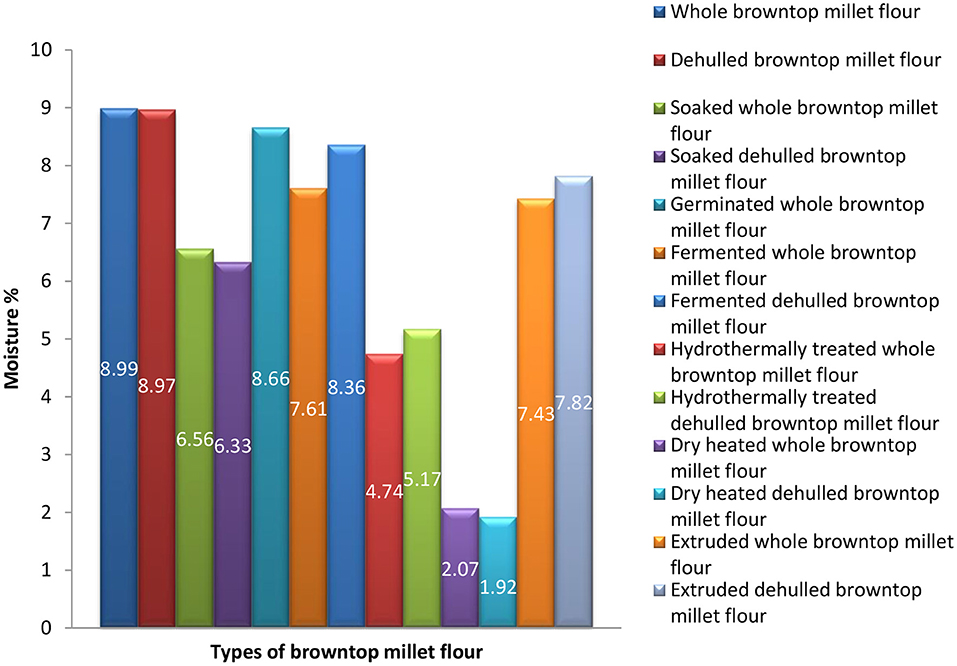
Figure 2. Moisture content of differently processed browntop millet flour. Source: Sirisha et al. (2022).
Seed mass: Seed mass is related to the size of the seeds. Larger seeds have higher tendency to germinate. It is also closely related to nutrient content. According to Saini and Sasmal (2022) the mass of 1,000 BTM grains was 3.66 ± 0.00 g. One thousand grains were counted, and afterwards, the weight of grains were recorded in grams to the closest one decimal point. Other studies conducted by Nagaraju et al. (2020) and Titkare et al. (2021) found the mean weight of 1,000 BTM seeds to be 3.42 ± 0.14 g and 2.49 g,respectively.
Seed volume: Seed volume is inversely proportional to the seed density means higher the density lowers the volume, vice-versa. Seed volume of BTM has been reported to be 3.00 ± 0.00 ml by Mohsenin (1986). To calculate the seed volume of BTM one thousand BTM grains were counted and transferred to a 50 ml measuring cylinder and 25 ml of demineralized water was added to it.
Bulk density: The bulk density is the ratio of the mass of seed samples to its total volume. It is a function of the closeness of packaging (Khatoniar and Das, 2020). To find bulk density ten grams of the BTM grain are placed in a 25 ml graduated cylinder and packed by gentle tapping of the cylinder on a bench top, ten times, from a height of 5–8cm. The final volume of the grain is expressed as bulk density (Ramashia et al., 2018). Bulk density of BTM was found to be 0.67 ± 0.00 g/ml by Sravani et al. (2020). Nagaraju et al. (2020) and Titkare et al. (2021) have reported the bulk density of BTM grains to be 601.17 ± 4.08 kg/m3 and 545 kg/m3, respectively.
Porosity: It is defined as the ratio of empty space of seeds to its total volume and it is important in storage process. The porosity of BTM was reported to be 87.78 ± 1.11% by Sravani et al. (2020). Similar studies found the porosity as 58.34% (Titkare et al., 2021) and 53.74 ± 3.23% (Nagaraju et al., 2020).
Ash content: Ash content represents the total mineral content and hence the nutritive value of a food. The ash content of BTM has been reported to range from 1.58 to 1.99 g/100 g by Saini and Sasmal (2022). The ash content reported in similar studies has been 8.62% (Hemamalini et al., 2021), 2.13 ± 0.21 g/100 g (Kishore et al., 2021) and 1.99 ± 0.01 g/100 g Saini and Sasmal (2022). The ash content of BTM is thus greater than rice (0.56 ± 0.08 g/100 g), wheat (1.42 ± 0.19 g/100 g), sorghum (1.39 ± 0.34 g/100 g), pearl millet (1.37 ± 0.17 g/100 g), foxtail millet (1.72 ± 0.27 g/100 g), finger millet (2.04 ± 0.34 g/100 g) and little millet (1.34 ± 0.16 g/100 g).
Dimensional properties: Dimensions include length, width and thickness of a seed. Seed length is the largest linear dimension of a seed, seed width is the largest linear dimension of the same seed perpendicular to the length-axis at its mid-point and seed thickness is the largest linear dimension of the same seed perpendicular to both the length-axis and the width-axis at their mid-points (Ganhao and Dias, 2019). The mean values of length, width and thickness of the BTM were found to be 3.00 ± 0.21, 1.79 ± 0.10 and 1.15 ± 0.09 mm. The average results of the geometric mean diameter and arithmetic mean diameter were found to be 1.82 ± 0.09 and 1.99 ± 0.1 mm at moisture content of 11.2 ± 0.16% (Nagaraju et al., 2020). Dayakar et al. (2019) has also reported the similar results for geometric and arithmetic mean diameter.
Color and Shape: Color and shape of millet distinguishes it from the other millets. It also influences sensory appeal. BTM is small greenish oval grain (Figure 3). The tristimulous color values for the BTM as determined by Minolta chromameter were found to be L* = 60.45 ± 0.44, a* = 3.78 ± 0.06 and b* = 14.71 ± 0.33. The L*, a* and b* values help to find out the color of the millet. The shape of the BTM was oval having sphericity of 59.82 ± 2.60% (Nagaraju et al., 2020). The shape of the kodo millet (Gomez and Gupta, 2003) is very similar to browntop millet. Its shape was determined by comparing the images (shapes) of BTMs with the standard shapes presented in the chart by Mohsenin (1986). The lengths of whole and dehulled BTM were found to be in the range of 1.79 ± 0.00 mm−3.19 ± 0.11 mm and 1.46 ± 0.00 mm−1.93±0.03 mm, respectively (Sravani et al., 2020).
Nutritional attributes
Millets have unique nutrient composition which is good for physical and mental health. They have high fiber and vitamin content, low simple carbohydrates (ICAR-IIMR, 2016-17). Browntop millet is high in nutrition and has high energy content; 100 grams of BTM contains 338 Kcal of energy, 71.32 g of carbohydrate, 8.98 g of protein, and 1.89 g of fat (Roopa, 2015). It is a rich source of natural fiber i.e., 8.5% (Kishore et al., 2021). Consumption of dietary fiber has long been associated with health benefits like bowel movement, and maintenance of normal blood cholesterol and glucose levels. Further, it is a rich source of micro nutrients such as iron, calcium, potassium, magnesium, zinc, phosphorus, and B group Vitamins (Sarita and Singh, 2016). Therefore, BTM may serve as budding grain for therapeutic diets (Hithamani and Srinivasan, 2014).
According to Kishore et al. (2021), BTM is a good source of several minerals. It contains the 28 mg of calcium, 7.72 mg of iron, 276 mg of phosphorus, 60 mg of potassium, 94.5 mg of magnesium, 1.99 mg of manganese, 7.60 mg of sodium, 2.5 mg of zinc, 1.23 mg of copper per 100 gram of grain. Therefore, BTM can be considered as a dietary component which may support the prevention and management of certain non-communicable diseases (Kishore et al., 2021). The residual stalk including stem and leaves after harvesting the BTM (Panicum ramosum L.) is used as livestock feed because it contains 56.7 g/kg of crude protein and 594.2 g/kg of total digestible nutrient (Kering and Broderick, 2018) along with higher level of minerals like magnesium (5.9 g/kg), phosphorus (1.5 g/kg), and calcium (9.0 g/kg). High fiber content and presence of some anti-nutritional factors like phytates and tannins in millets affect bioavailability of minerals but these compounds are limited to millet seed coat which can be removed during processing (Ramashia et al., 2019). According to the Tables 3, 4 which shows comparison of macronutrients and micronutrients of different millets and staple cereals with the browntop millet (in percent), BTM contains 8.98 gm/100 gm of protein which is higher than protein of rice, wheat, sorghum, proso millet, finger millet, little millet, barnyard millet and kodo millet. Fat content of BTM is 1.89 gm/100 gm which is much higher than fat content of rice, wheat and sorghum. 71.32 gm/100 gm is the carbohydrate content of BTM that is higher than wheat, sorghum, pearl millet, proso millet, finger millet, little millet, barnyard millet and foxtail millet. Crude fiber value of BTM is 8.06 gm/100gm which is higher than rice, proso millet, little millet, foxtail millet and kodo millet. The energy value of BTM is 1414 kj/100 gm which is greater than energy value of wheat, sorghum, proso millet, finger millet, barnyard millet and foxtail millet. Calcium content of BTM is 28 mg/100 gm which is higher than calcium content of rice, pearl millet, proso millet, little millet and barnyard millet. Iron content of BTM is 8.86 mg/100 gm which is higher than iron content of all the millets and staple cereal grains i.e., rice and wheat. According to ICMR (2010), the bioavailability of iron is higher in case of rice based Indian diets (4–5%), followed by wheat Indian based diets (1.7–1.9%) and millet based Indian diet (0.8–0.7%). Keeping this assumption in mind, if BTM is substituted by rice in 1:1 ratio in typical Indian diets, the total iron absorption would be 5.02% higher. Similarly, if BTM is included in 1:1 ratio with wheat, the total iron absorption would be 172.6% higher. Phosphorus content of BTM is 276 mg/100 gm which is higher than phosphorus content of rice, sorghum, proso millet, finger millet and little millet while zinc in BTM is 2.5 mg/100 gm which is higher than zinc content of rice, sorghum, proso millet, little millet, foxtail millet and kodo millet.
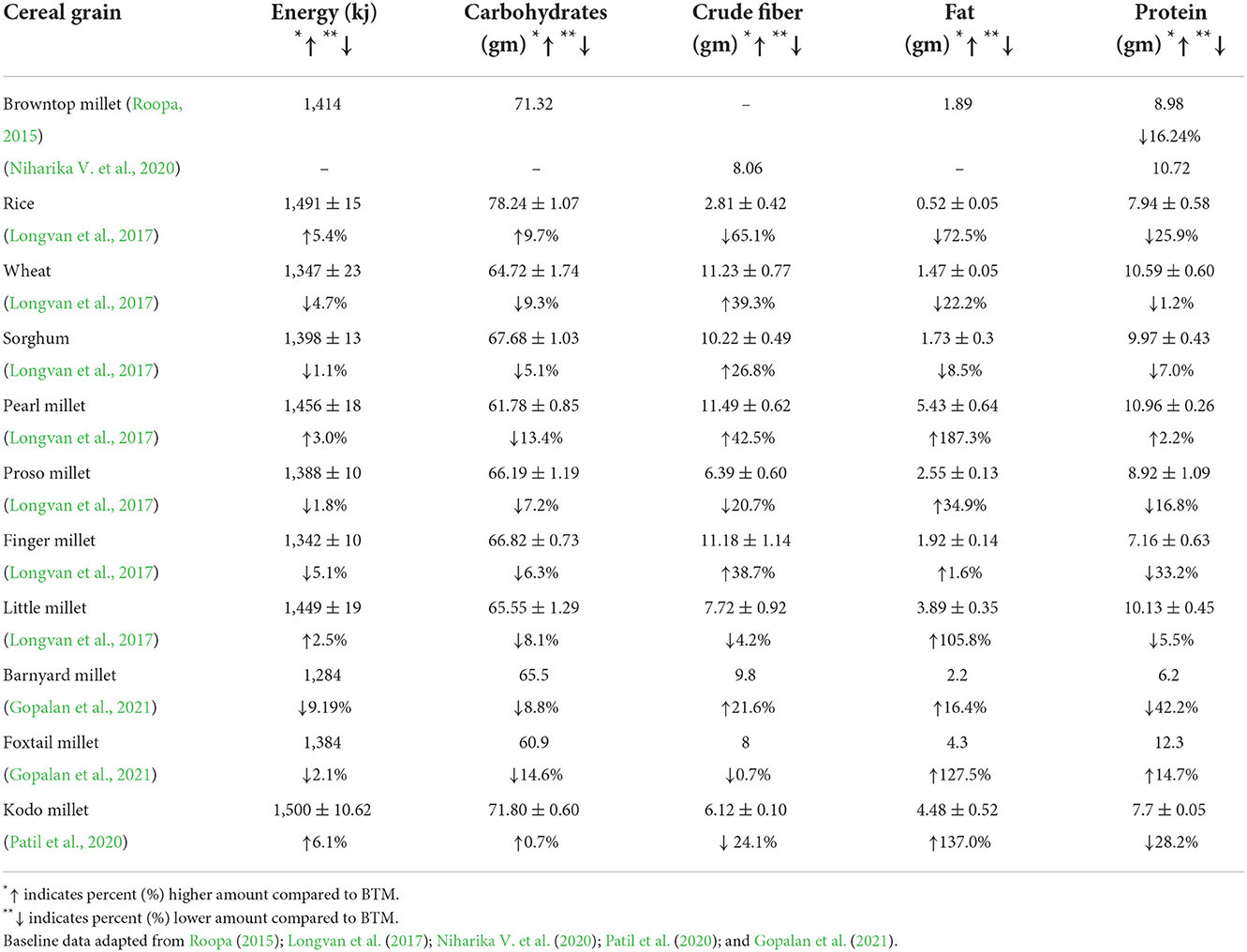
Table 3. Energy and macro-nutrient content of different millets and staple cereals compared with the browntop millet (in percent).
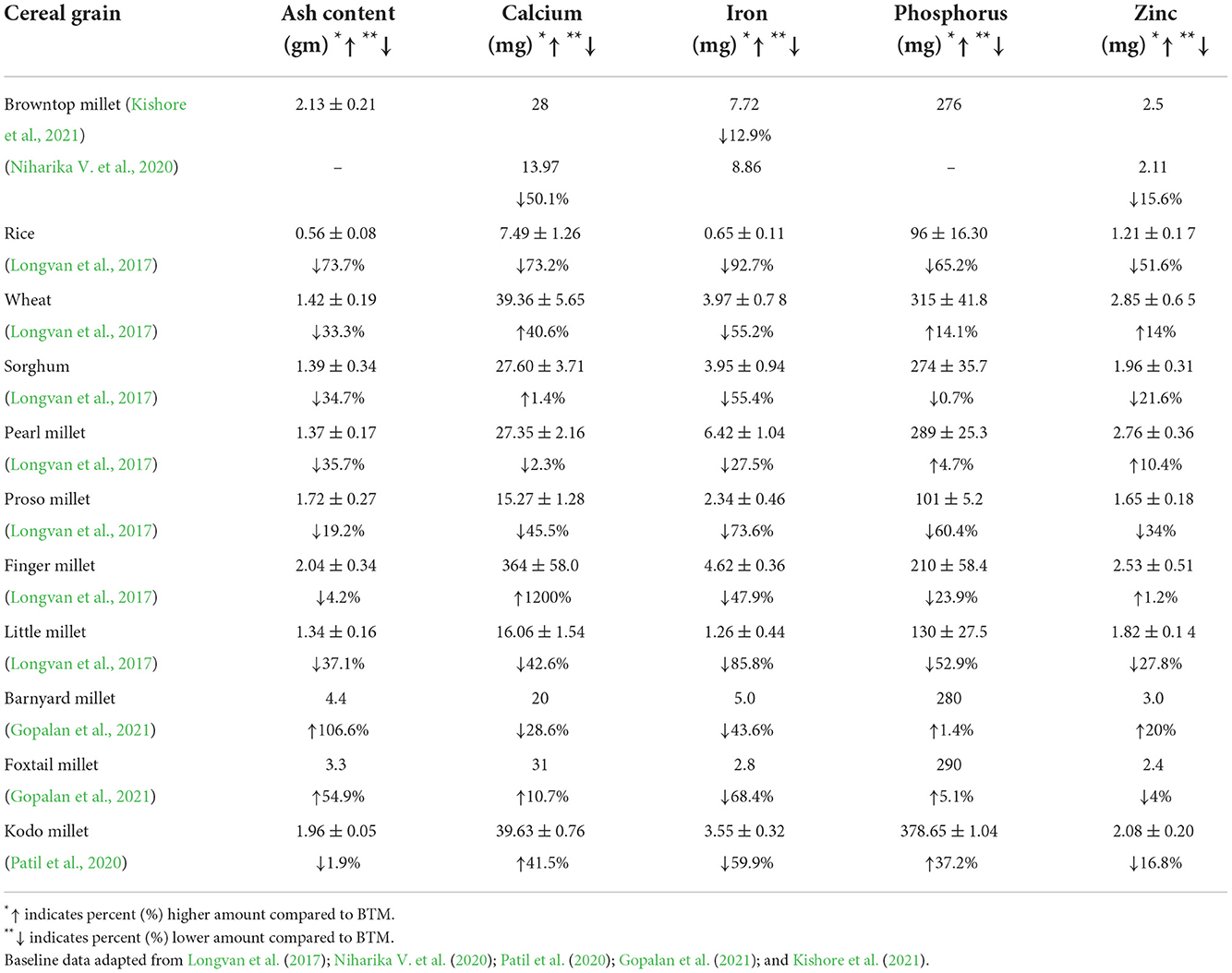
Table 4. Comparison of micro-nutrients content of millets and staple cereals with the browntop millet (in percent).
According to Niharika B. et al. (2020), millets are rich in phytochemicals, also known as secondary metabolites such as flavonoids, quinones, phenols, tannins, alkaloids, besides carbohydrates and proteins. Her study found that flavonoids, tannins, resins and quinones were found to be present in BTM whereas in pearl millet, finger millet, sorghum and foxtail millet flavonoids and quinones they were not detected. Amount of phytochemicals present in BTM are unknown therefore, emphasis need to be given to find out the exact amount of therapeutic compounds present in BTM. Millets exhibit variable antimicrobial activities. The antimicrobial activity of various millets was studied by Niharika B. et al. (2020) and antimicrobial activity of BTM against Bacillus subtilis was in the lowest zone of inhibition i.e., 20 mm and highest zone of inhibition (30 mm) was shown by foxtail millet.
Millets are safe when consumed in a moderate amount. They have been consumed as staple food by millions of peoples in the past thousands of years. However, excessive consumption of millet might cause adverse effects. For example, millets contain phytic acids; it is a chelating agent which binds with cations of potassium, calcium, iron, zinc, magnesium and other cations and reduces their bioavailability in the body (Boncompagni et al., 2018). Besides phytic acid, goitrogens are also present. Goitrogens interfere with the production of thyroid hormones and inhibits iodine uptake and utilization by the thyroid gland (Gaitan et al., 1989). Deficiency of iodine leads to an array of Iodine Deficiency Disorders. In the Sudan region of Africa where millet is consumed as the primary source of energy, the occurrence of goiter has been found to be much greater than anywhere else in the world (Eltom et al., 1984). Hence, people with thyroid problems need to restrict consumption of millets. Other anti-nutritional factors present in millets/BTM include phenols, tannins, and enzyme inhibitors, and also a high amount of protease and amylase inhibitors that affect the digestibility of millets grains (Vetriventhan et al., 2020).
Thus, the advantage of having higher content of micronutrients may to some extent be nullified by lower bioavailability. More studies using state of art techniques and different methods of cooking are needed to examine the bioavailability of micronutrients including minerals and B-vitamins to ascertain the nutritional advantage in vivo especially for BTM. Processing can improve the bioavailability of nutrients as well as functionality of BTM grains. Limited studies show that bioavailability as well as functionality differs with the type of processing and preparation.
Processing of BTM has been studied by some researchers. Processing techniques like soaking and fermentation reduce the interaction between nutrients and anti-nutritional factors. They have been found to enhance the antioxidant activity and total phenolic compounds of BTM. Fermentation using curd has been found to increase nutritional value at a low cost for browntop millet Saini and Sasmal (2022). Millet grains, before consumption are usually processed by commonly used traditional techniques such as decortication, malting, fermentation, roasting, flaking, and grinding to improve their edible, nutritional, and sensory properties (Ahmed et al., 2006; Vinoth and Ravindhran, 2017). This could improve bioavailability of nutrients. However, the extent to which bioavailability may improve, need to be ascertained by systematized research.
Sirisha et al. (2022) analyzed the nutritive value of different types of browntop millet (brachiaria ramosa) flour obtained through various processing methods i.e., soaking, germination, fermentation, dry heating, hydrothermal treatment and extrusion cooking. According to the study, germinated whole browntop millet flour had lowest amount of energy i.e., 365.2 ± 2.4 kcal/100 g and highest energy value was recorded in hydrothermally treated dehulled browntop millet flour i.e., 396.5 ± 0.8 kcal/100 g. Lowest amount of carbohydrate was found in whole browntop millet flour i.e., 58.00 ± 1.06% and highest (79.68 ± 0.75%) in dry heated whole browntop millet flour. Hydrothermally treated dehulled browntop millet flour had lowest crude fiber i.e., 2.42 ± 0.16% while highest amount of crude fiber was present in fermented whole browntop millet flour i.e., 19.44 ± 0.29%. Lowest percent of fat was recorded in dry heated whole browntop millet flour i.e., 4.16 ± 0.08%, while fermented dehulled browntop millet flour had the highest amount of (7.08 ± 0.03%) fat. Fermented whole browntop millet flour had the lowest amount (6.10 ± 0.06%) of protein and dehulled browntop millet flour had highest amount (17.31 ± 0.25%). Refer Table 5 for details. Low ash content was recorded in soaked dehulled browntop millet flour i.e., 1.79 ± 0.17% and 5.80 ± 0.15% was the highest recorded in germinated whole browntop millet flour (Figure 4). Almost all the BTM flour had ash content higher than wheat—the staple cereal used in India. No, specifications have been given by Food Safety and Standards Authority of India (FSSAI) (2011), for millet flours. Such data can be used to develop specifications by regulatory agencies. Thus, to prepare value-added macronutrient rich products dry heated whole browntop millet flour and fermented dehulled browntop millet flour can preferably be used because it has highest energy value percentage of carbohydrates and fat i.e., 85.06% and 16.65%, germinated whole browntop millet flour had highest energy value of crude fiber i.e., 12.15%. Highest energy value of protein is 18.61% recorded in dehulled browntop millet flour.
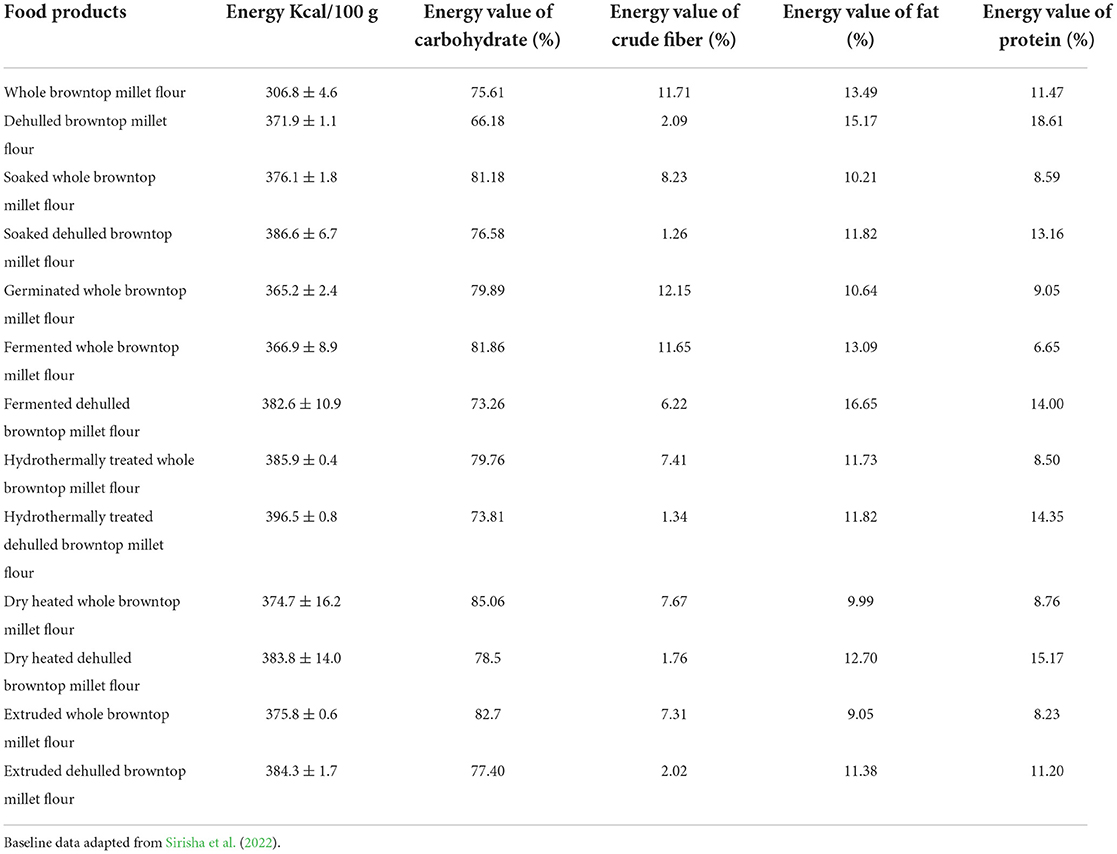
Table 5. Percentage of energy value of macronutrients of differently processed food products of browntop millet.
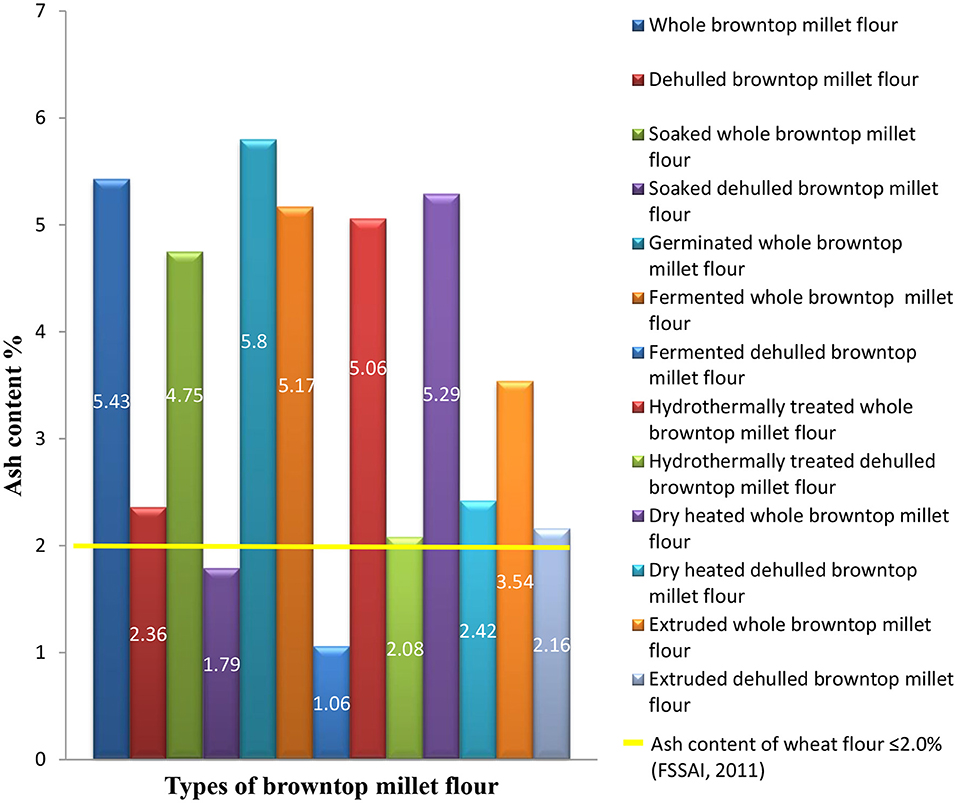
Figure 4. Ash content of differently processed browntop millet flour. Source: Sirisha et al. (2022).
Niharika V. et al. (2020) studied nutritional traits and grain yield of 30 indigenous collections of BTM (Brachiaria ramosa (L.) Stapf.). It was found that the protein content varied from 8.93% to 19.33% with a mean of 10.72%, crude fiber content varied from 6.5% to 9.87% with a mean of 8.06%, iron content was between 3.70 mg/100 g and 15.32 mg/100 g with a mean of 8.86 mg/100 g, zinc content from 1.36 mg/100 g to 2.8 mg/100 g with a mean of 2.11 mg/100 g, calcium content was from 8.00 mg/100 g to 33.00 mg/100 g with a mean of 13.97 mg/100 g, and grain yield per plant ranged from 4.74 g to 20.38 g with a mean of 12.13 g. The genotype IC 613556 had highest protein content, IC 613554 had highest crude fiber content, IC 617957 had highest iron content, IC 606693 and the “28 bijapur collection” had highest zinc content, IC 617952 had highest calcium content, and IC 617961 had high grain yield per plant (Figures 5, 6).
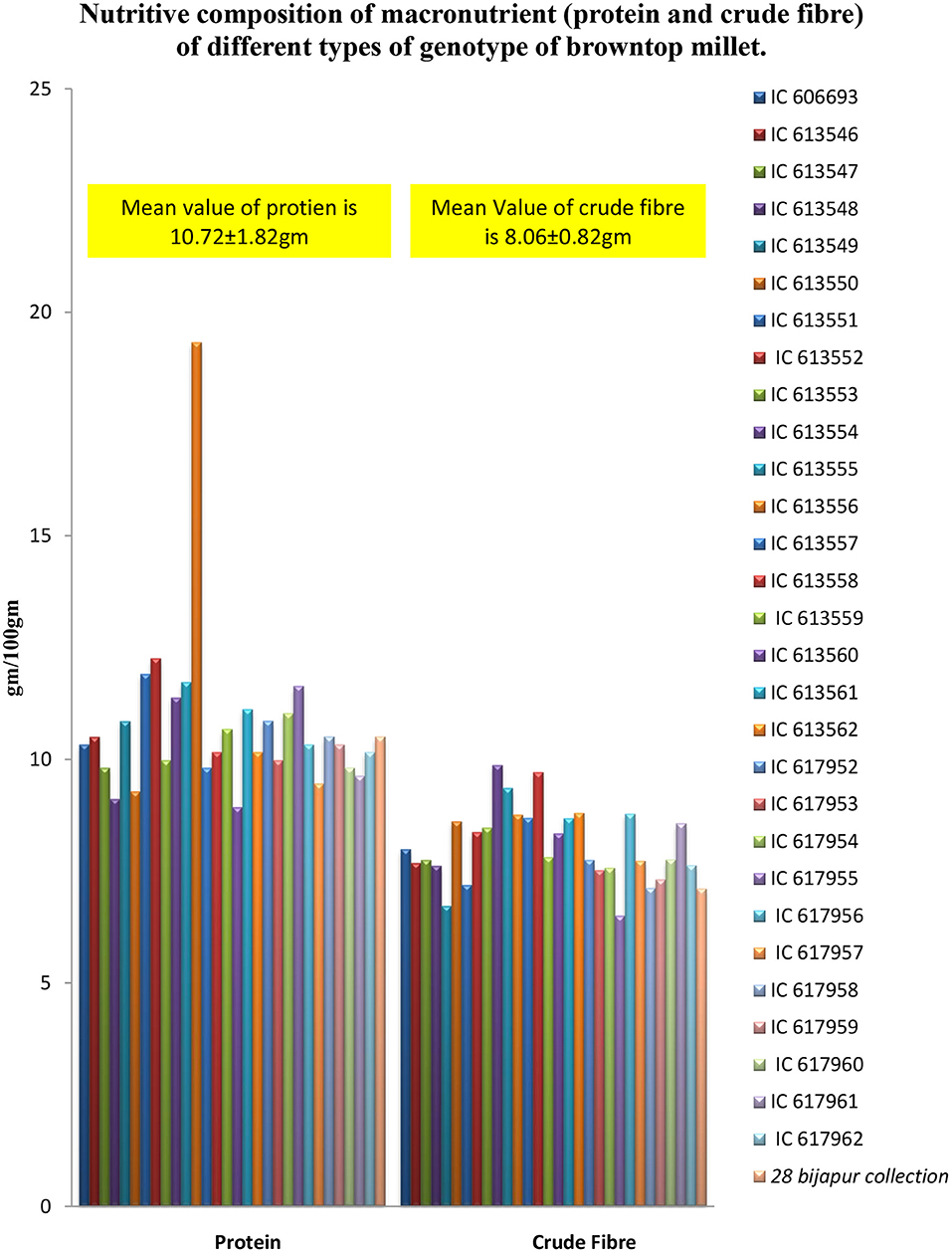
Figure 5. Nutritive composition of macronutrient (protein and crude fiber) of different types of genotype of browntop millet. Source: Niharika V. et al. (2020).
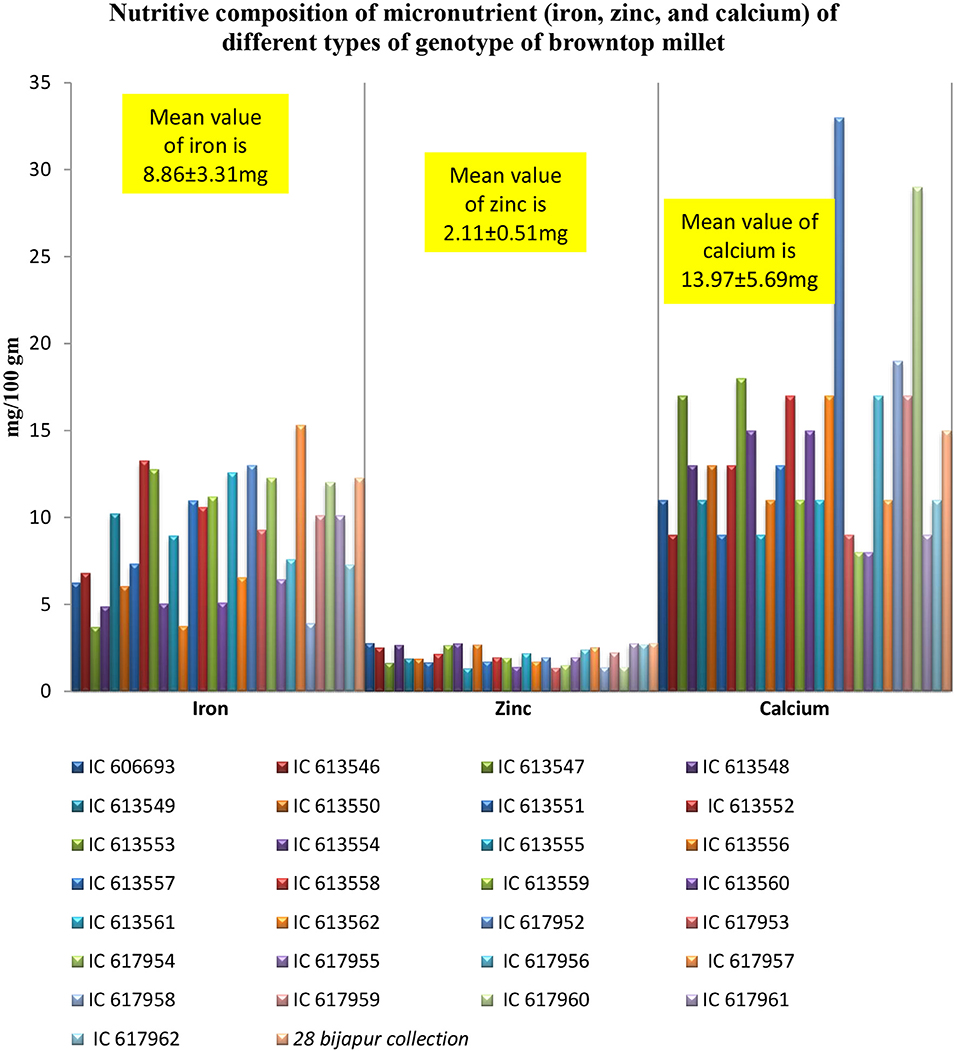
Figure 6. Nutritive composition of micronutrient (iron, zinc, and calcium) of different types of genotype of browntop millet. Source: Niharika V. et al. (2020).
A study was conducted by Saini and Sasmal (2022) in which the effect of fermentation on the total phenolic compound content of BTM (brachiaria ramosa) samples was studied. It was found that the batch of BTM which was fermented for 18 h possessed the highest total phenolic content i.e., 73.50%w/w whereas unfermented BTM had low phenolic content i.e., 27.16%. BTM fermentation for 12 h and 48 h had 68 μmol (highest) and 52.54 μmol (lowest) iron (Fe(II)/ml) content.
Uses
Browntop millet is a crop of versatile use as it is grown as food for human consumption, forage and food for birds and as raw material for industries (Sheahan, 2014). In countries like India and Africa, small millets are consumed as whole or in form of flour. They are mainly used as food and for allied purposes, whereas in Japan they are mainly used as birds feed (Asharani et al., 2010). Studies report that under drought and cold stressed conditions the nitrate level reaches to toxic or lethal level and the forage obtained should not be fed to animals. In Southern part of India the grains of browntop millet from non-shattering varieties are consumed as boiled whole grain (like rice), porridge, kheer or unleavened bread and dosa (Nesbitt, 2005).
According to Reddy and Prasad (2017), BTM can be used to prepare a variety of dishes. Its grains are used in preparing at least nine traditional foods in southern India such as anna, dosai, kheer, nuchina mudda, roti, nippattu, chakkulli, haralu, kodubale and kadabuappe. Browntop millet is usually ground into flour and used to make flat breads like roti or dosa or polished and boiled to make gruel (kheer). Some of these foods are used in religious rituals, which may partly account for its persistence in cultivation (Kimata et al., 2000).
For human consumption, there is enough scope for value addition in the form of idli mix or making of biscuit by proportionately mixing browntop millet with other flours of major cereals, namely, rice and wheat (Roopa, 2015). BTM is an effective crop, much like oats (Bhat et al., 2018). Various ready-to-eat (RTE) and ready-to-cook (RTC) value-added products have been developed by University of Agricultural Science, Dharwad like laddu, cookies and dosa mix by using BTM as a core ingredient. BTM has been mixed with other ingredients like coconut, chocolate, drumstick etc (Table 6).
Millets fall under the category of C4 cereals. C4 cereals take more carbon dioxide (CO2) from the atmosphere and convert it to oxygen (O2), require low input, have high efficiency of water use, and hence, are more environment friendly. Thus, millets can help to phase out climatic uncertainties, reducing carbon dioxide from atmosphere, and can contribute in mitigating the climate change (Kumar et al., 2018). BTM is drought-tolerant, early maturing and harvested in about 75–80 days earlier than other millets. This millet is well suited for dry land, grown under a variety of soils and climates (Kishore et al., 2020, 2021).
Health benefits
Millets have been recognized as smart foods in view of their health benefits by International Crops Research Institute for the Semi-Arid Tropics. BTM is also rich in fiber i.e., 12.5 gm per 100 gram (Indian Institute of Millets Research (IIMR), 2022) and fiber helps to detoxify the body by removing the waste from the intestine. Fiber gets fermented in the colon and act as a prebiotic in the colon (Lei et al., 2006). Due to its high fiber content, if consumed regularly, BTM can help in the prevention and management of several non-communicable or lifestyle related diseases such as constipation, diverticulosis, dyslipidemia, metabolic syndrome to name a few (Dayakar et al., 2017; Ashoka and Sunitha, 2020). Millets have low glycemic index (GI). Because of the low GI, millets help in gradual increase in the post-prandial blood glucose levels. This is particularly helpful for patients suffering from impaired glucose tolerance as well as diabetes.
BTM contains good amount of minerals. It has significant levels of magnesium which is 94.5 mg/100 gm (Kishore et al., 2021). Magnesium is a vital mineral which aid in increasing the efficiency of insulin and glucose receptors by supporting many carbohydrate digesting enzymes, which manages insulin action (Hemamalini et al., 2021) and it also helps to reduce the pressure on blood vessels (Ashoka and Sunitha, 2020) which make it capable of reducing the effects of myocardium infarction and migraine (Sarita and Singh, 2016). BTM is gluten free and an excellent choice for people suffering from celiac disease (Saleh et al., 2013). BTM contain 276 mg per 100 gm phosphorous (Kishore et al., 2021). Phosphorous is involved in the structure of every cell in the body, forming the mineral matrix of bone and essential component in molecule i.e., adenosine triphosphate (ATP) also known as energy currency of the body (Hemamalini et al., 2021).
Besides fiber and minerals, millets are also rich in health-promoting phytochemicals like polyphenols, lignans, phytosterols, phyto-oestrogens, phytocyanins, phenolic compounds, tannis and flavonoids like, anthocyanins, carotenoids, and tocopherols. They are natural antioxidant that protect the phospholipid membrane around heart, nerves, muscles, and red blood cells from the attack of free radicals and thus prevent carcinogenesis, and aging (Theriault et al., 1999; Chandrasekara and Shahidi, 2010; Dayakar et al., 2018). Carotenoids are reported to prevent cardiovascular diseases like atherosclerosis, (Dwyer et al., 2001), maintain normal functioning of immune system, and retina of eyes (Beatty et al., 1999; Hegde et al., 2002; Chandrasekara and Shahidi, 2010; Sarita and Singh, 2016; Niharika B. et al., 2020). These also function as, immune modulators and detoxifying agents. BTM being rich in secondary metabolites (phytochemicals) can help to reduce the risk for gastric ulcers and colon cancer.
Discussion
Scope for future research
This study indicates that while scanty literature and isolated studies are available on BTM:- systematized evidence based literature and research is lacking. So far BTM is not listed in the “generally regarded as safe” (GRAS) list and no specific regulations have been outlined for this millet by the Food Safety and Standards Authority of India. There is an emergent need to carry systematized research in various salient areas pertaining to BTM such as nutritional and non-nutritional components in various varieties of BTM, especially those grown in various parts of India, in-vitro and in-vivo studies related to consumption of BTM, toxicological studies for various varieties and different parts of the plant (on both human and animal), bioavailability of nutrients from BTM in typical Indian diet, scope of value-added products prepared by using BTM, sensory and analytical studies on BTM and products/dishes made from BTM, scope of establishment of market linkages for BTM grains as well as innovative products made from BTM, scope of bio-fuels from BTM plant post-harvest, development, standardization and safety/efficacy studies on designer food products using BTM for specific diseases, development of regulations related to the production, processing, sale of BTM in India as well as for export, assessing the optimal use of water, manure, fertilizers for BTM, assessing the quality of BTM currently available in the market, animals studies on the safety aspects of using BTM as feed, promoting non-food uses of BTM plants such as in textiles, handicrafts, etc., e-database or e-repository on cultivation, availability, composition and research work done in above areas.
Conclusion
Millets are increasingly being considered for promoting food and nutrition security and contributing toward the attainment of Sustainable Development Goals. While some millets are familiar to mankind, others are even difficult to obtain by the general masses in the local market. Browntop millet (BTM) is one such nutrient dense grain about which not much scientific evidence based information is available thereby making it difficult for young and experienced researchers to work in this area worldwide. Absence of evidence backed literature is also hindering the use of BTM among the masses and its use in government/ non-government supplementary food programmes and the public distribution system. While BTM has been used in many traditional dishes, its safety aspects need to be ascertained. It is yet not listed in the “generally regarded as safe” list. Availability, accessibility and affordability of BTM also is a challenge which hinders its incorporation in daily dietaries. Active participation of policy makers, academia and farmers can help unleash the unrealized potential of browntop millet. Government of India has been taking several steps to popularize the consumption of millets by the masses as a step toward food and nutrition security. As part of the International year for millet i.e., 2023, the government of India is promoting popularization of millets through series of lectures/talks, competitions, millet bazaars (local markets), provision of millet based snacks/meals in canteens/cafeterias and research for students, faculty and staff in academic institutions. These and other similar awareness generation initiatives/campaigns may prove to be beneficial in promoting consumption of millets including BTM by the masses at large.
Data availability statement
The original contributions presented in the study are included in the article/supplementary material, further inquiries can be directed to the corresponding author.
Author contributions
All authors contributed to the preparation of this article.
Funding
This work was funded by University Grants Commission (UGC Grant No. 210510028899) funds received though University of Delhi.
Acknowledgments
We acknowledge the financial support received from University of Delhi (Junior Research Fellowship). We are thankful to Dr. Komal Chauhan (National Institute of Food Technology, Entrepreneurship and Management) for her expert opinion.
Conflict of interest
The authors declare that the research was conducted in the absence of any commercial or financial relationships that could be construed as a potential conflict of interest.
Publisher's note
All claims expressed in this article are solely those of the authors and do not necessarily represent those of their affiliated organizations, or those of the publisher, the editors and the reviewers. Any product that may be evaluated in this article, or claim that may be made by its manufacturer, is not guaranteed or endorsed by the publisher.
References
Ahmed, M. B., Hamed, R. A., Ali, M. E., Hassan, A. B., and Babiker, E. E. (2006). proximate composition, antinutritional factors and protein fractions of guar gum seeds as influenced by processing treatments. Pakistan J. Nutr. 5, 481–484. doi: 10.3923/pjn.2006.481.484
Asharani, V. T., Jayadeep, A., and Mallesi, N. G. (2010). Natural antioxidants in edible flours of selected small millets. Int. J. Food Prop. 13, 41–50. doi: 10.1080/10942910802163105
Ashoka, P., and Rajkumar, G. R. (2020). Response of nutrient management on growth and yield attributes of Brown top millet [Brachiaria ramose] in red sandy soil. J. Pharmacogn. Phytochem. 9, 1298–1301. doi: 10.22271/phyto.2020.v9.i6s.13130
Ashoka P. and Sunitha, N. H. (2020). Review on browntop millet – a forgotten crop. J. Exp. Agric. Int. 42, 54–60. doi: 10.9734/jeai/2020/v42i730553
Beatty, S., Boulton, M., Koh, H. H., and Murray, I. J. (1999). Macular pigment and age related macular degradation. Br. J. Ophthalmol. 83, 867–877. doi: 10.1136/bjo.83.7.867
Bhat, S., Ganiger, P. C., Nandini, C., and Thippeswamy, V. (2018). Browntop millet – a review. Agri Res and Tech: Open Access J. 14, 555937. doi: 10.19080/ARTOAJ.2018.14.555937
Boncompagni, E., Orozco-Arroyo, G., Cominelli, E., Gangashetty, P. I., Grando, S., Kwaku Zu, T. T., et al. (2018). Antinutritional factors in pearl millet grains: phytate and goitrogens content variability and molecular characterization of genes involved in their pathways. PLoS ONE 13, e0198394. doi: 10.1371/journal.pone.0198394
Chandel, G., Meena, R. K., Dubey, M., and Kumar, M. (2014). Nutritional properties of minor millets: neglected cereals with potentials to combat malnutrition. Curr. Sci. 107, 1109–1111.
Chandrasekara A. and Shahidi, F. (2010). Content of insoluble bound phenolics in millets and their contribution to antioxidant capacity. J. Agric. Food Chem. 58, 6706–6714. doi: 10.1021/jf100868b
Clayton, W. D., Vorontsova, M. S., Harman, K. T., and Williamson, H. (2006). Grass Base–The Online World Grass Flora. London: Royal Botanic Gardens.
Cooke, M., Fuller, D. Q., and Rajan, K. (2005). “Early historic agriculture in southern Tamil Nadu: archaeobotanical research at Mangudi, Kodumanal and Perur,” in South Asian Archaeology 2003: Proceedings of the European Association for South Asian Archaeology Conference, Bonn, Germany, 7th-11th July 2003, eds U. Franke-Vogt and J. Weisshaar (Aachen: Linden Soft), 329–334.
Dayakar, R. B., Ananthan, R., Hariprasanna, K., Bhat, B. V., Rajeswari, K., Sharma, S., et al. (2018). Nutritional and Health Benefits of Nutri-Cereals. Rajendranagar, Hyderabad: ICAR-Indian Institute of Millets research. 96.
Dayakar, R. B., Bhaskarachary, K., Arlene Christina, G. D., Sudha Devi, G., and Tonapi, V. A. (2017). Nutritionsal and Health benefits of Millets. Rajendranagar, Hyderabad: ICAR-Indian Institute of Millets research (IIMR). 112.
Dayakar, R. B., Bhandari, R., and Tonapi, V. A. (2021). White Papers on Millets – A Policy Note on Mainstreaming Millets for Nutrition Security. Rajendranagar, Hyderabad: ICAR-Indian Institute of Millets research (IIMR).
Dayakar, R. B., Sharma, S., Kiranmai, E., and Tonapi, V. A. (2019). Effect of processing on the physiochemical parameters of minor millet grains. Int. J. Chem. Stud. 7, 276–281.
Dwyer, J. H., Navab, M., Dwyer, K. M., Hassan, K., Shircore, A., Hamalevy, H. G., et al. (2001). Oxygenated carotenoid lutein and progression of early atherosclerosis: the Los Angeles Atherosclerosis Study. Circulation 103, 2922–2927. doi: 10.1161/01.CIR.103.24.2922
Eltom, M., Hofvander, Y., Torelm, I., and Fellstrom, B. (1984). Endemic goitre in the Darfur region (Sudan): epidemiology and aetiology. Acta Med Scand. 215, 467–475. doi: 10.1111/j.0954-6820.1984.tb17680.x
FAOSTAT. (2022). Food and Agricultural Organization of United Nations. Available online at: https://www.fao.org/faostat/en/#data/QCL (accessed July 25, 2022).
Food Safety Standards Authority of India (FSSAI) (2011). Food Safety and Standards (Food Products Standards and Food Additives) Regulation. 359. Available online at: June-Food-160811.pmd(fssai.gov.in) (accessed June 17, 2022).
Fuller, D. Q. (2006). Agricultural origins and frontiers in South Asia: a working synthesis. J. World Prehistory 20, 40–51. doi: 10.1007/s10963-006-9006-8
Fuller, D. Q., korisettar, R., Venkatasubbaiah, P. C., and Jones, M. K. (2004). Early plant domestications in southern India: some preliminary archaeobotanical results. Veg. Hist. Archaeobot. 13, 115–129. doi: 10.1007/s00334-004-0036-9
Gaitan, E., Lindsay, R. H., Reichert, R. D., Ingbar, S. H., Cooksey, R. C., Legan, J., et al. (1989). Antithyroid and goitrogenic effects of millet: role of C-glycosylflavones. J. Clin. Endocrinol. Metab. 68, 707–714. doi: 10.1210/jcem-68-4-707
Ganhao E. and Dias, L. S. (2019). Seed volume dataset – an ongoing inventory of seed size expressed by volume. Data 4, 61. doi: 10.3390/data4020061
Gomashe, S. S. (2017). “Barnyard millet: Present status and future thrust areas,” in Millets and Sorghum: Biology and Genetic Environment (Wiley Online Library), 184–198. doi: 10.1002/9781119130765.ch7
Gomez M. I. and Gupta, S. C. (2003). Millets. Encyclopedia of Food Sciences and Nutrition, 2nd Edn. Bulawayo: Academic Press. 3974–3979. doi: 10.1016/B0-12-227055-X/00791-4
Gopalan, C., Rama Sastry, B. V., Balasubramanian, S. C. (revised by Rao, B. S. N., Deosthale, Y. G., and Pant, K. C.) (2021). Nutritive Value of Indian Foods (NVIF). National Institute of Nutrition, Indian Council of Medical Research, Hyderabad, India.
Goswami, D., Gupta, R. K., Murida, D., Sharma, M., and Tyagi, S. K. (2015). Barnyard millet based muffins: physical, textural and sensory properties. LWT-Food Sci. Technol. 64, 374–380. doi: 10.1016/j.lwt.2015.05.060
Harvey, E. L. (2006). Early Agricultural Communities in Northern and Eastern India: An archaeobotanical investigation (Ph.D. thesis). Institute of Archaeology, University of London, London, United Kingdom.
Hegde, P. S., Chandrakasan, G., and Chandraa, T. S. (2002). Inhibition of collagen glycation and crosslinking in vitro by methanolic extracts of finger millet (Eleusine coracana) and kodo millet (Paspalum scrobiculatum). J. Nutr. Biochem. 13, 517–521. doi: 10.1016/S0955-2863(02)00171-7
Hemamalini, C.h., Sam, S., and Patro, T. S. S. K. (2021). Awareness and consumption of small millets. Pharma Innov. J. 10, 34–37.
Hithamani G. and Srinivasan, K. (2014). Effect of domestic processing on the polyphenol content and bioaccessibility in finger millet (Eleusine coracana) and pearl millet (Pennisetum glaucum). Food Chem. 164, 55–62. doi: 10.1016/j.foodchem.2014.04.107
ICAR-IIMR (2016-17). in Annual Report, eds R. Madhusudhana, P. Rajendrakumar, D. Cheruku, K. V. Raghavendra Rao, and V. A. Tonapi (Rajendranagar, Hyderabad, India), 132.
ICMR (2010). Nutrient Requirements and Recommended Dietary Allowances for Indians. National Institute of Nutrition. 212.
Indian Institute of Millets Research (IIMR) (2022). Available online at: http://www.iimr.res.in/millets_info.php (accessed March 05, 2022).
International Crop Research Institute for the Semi-Arid Tropics (ICRISAT) (2022). Available online at: https://www.icrisat.org/smartfood/ICRISAT (accessed June 17, 2022).
Kering M. K. and Broderick, C. (2018). Potassium and manganese fertilization and the effects on millet seed yield, seed quality and forage potential of residual stalks. Agric. Sci. 9, 888–900. doi: 10.4236/as.2018.97061
Khatoniar S. and Das, P. (2020). Physical and functional properties of some millet varieties of Assam. Int.J.Curr.Microbial.App.Sci. 9, 1508–1515. doi: 10.20546/ijcmas.2020.905.171
Kimata, M., Ashok, E., and Seetharam, A. (2000). Domestication, cultivation and utilization of two small millets, Brachiaria ramosa and Setaria glauca (Poaceae), in South India. Econ. Bot. 54, 217–227. 10.1007/BF02907825. doi: 10.1007/BF02907825
Kingwell-Banham E. and Fuller, D. Q. (2014). “Browntop millet: origins and development,” in Encyclopedia of Global Archaeology, ed C. Smith (New York, NY: Springer), 1021–1024. doi: 10.1007/978-1-4419-0465-2_2318
Kishore, A. S., Rekha, K. B., Hussain, S. A., and Madhavi, A. (2020). Growth and yield of BTM as influenced by dates of sowing and nitrogen levels. Int. J. Chem. Stud. 8, 1812–1815. doi: 10.22271/chemi.2020.v8.i5y.10564
Kishore, A. S., Rekha, K. B., Hussain, S. A., and Madhavi, A. (2021). Quality enhancement of nutri-cereal BTM through agronomic practices. Curr. Sci. 120, 468–470.
Kumar, A., Tomer, V., and Kaur, A. (2018). Millets: a solution to agrarian and nutritional challenges. Agric Food Secur. 7, 31. doi: 10.1186/s40066-018-0183-3
Lei, V., Friis, H., and Michaelsen, K. F. (2006). Spontaneously fermented millet product as a natural probiotic treatment for diarrhea in young children: an intervention study in Northern Ghana. Int. J. Food Microbiol. 110, 246–253. doi: 10.1016/j.ijfoodmicro.2006.04.022
Longvan, T., Ananthan, R., Bhaskarachary, K., and Venkaiah, K. (2017). Indian Food Composition Tables (IFCT). Hyderabad: National Institute of Nutrition.
Madhusudhana, R., Padmaja, P. G., Stanley, J., Anuradha, N., Rao, K. V. R., and Tonapi, V. A. (2021). Millets: Annual Report 2021. Rajendranagar, Hyderabad: ICAR-Indian Institute of Millets Research (IIMR).
Maitra, S. (2020). Potential horizon of brown-top millet cultivation in drylands: a review. Crop Res. 55, 57-63. doi: 10.31830/2454-1761.2020.012
Mohsenin, N. N. (1986). Physical Properties of Plant and Animal Materials, 2nd and updated Edn. New York, NY: Gordon and Breach Science Publisher. 1–715.
Nagaraju, M., Ramachandra, M., Nagarathna, S. B., Kalpana, B., Palanimuthu, V., and Darshan, M. B. (2020). Physical properties of an underutilized crop: BTM (Urochloa ramose). Int. J. Chem. Stud. 8, 192–197. doi: 10.22271/chemi.2020.v8.i6c.10768
Nesbitt, M. G. (2005). in The Cultural History of Plants, eds G. Prance and M. G.Nesbitt (New York: Routledge Press), 45–60.
Niharika, B., Jaipuriar, D. S., Ranjan, R., and Vaishnav, V. (2020). A study to explore the biochemical properties of locally grown millets. Int. J. Res. Anal. Rev. 7, 375–382.
Niharika, V., Rao, B. G., Tushara, M., and Rao, V. S. (2020). Studies on performance of browntop millet indigenous collections for grain yield and nutritional traits. J. Pharmacogn. Phytochem. 9, 2636–2638.
Oelke, E. A., Oplinger, E. S., Putnam, D. H., Durgan, B. R., and Doll, J. D. (1990). “Millets,” in Alternative Field Crops Manual. Madison: Univ of Wisc-Ext Serv, Univ of Minn ExtServ and Univ. of Minn. CAPAP.
Patil, R. B., Vijayalakshmi, K. G., and Vijayalakshmi, D. (2020). Physical, functional, nutritional, phytochemical and antioxidant properties of kodo millet (Paspalum scrobiculatum). J. Pharmacogn. Phytochem. 9, 2390–2393. doi: 10.20546/ijcmas.2020.909.348
Perumal, A. (2018). Production and consumption of minor millets in India- A structural break analysis. Ann Agriculture Res. 38, 1–8.
Ramashia, S. E., Anyasi, T. A., Gwata, E. T., Meddows-Taylor, S., and Jideani, A. I. O. (2019). Processing, nutritional composition and health benefits of finger millet in sub-Saharan Africa. Food Sci. Technol. 39, 253–266. doi: 10.1590/fst.25017
Ramashia, S. E., Gwata, E. T., Meddows-Taylor, S., Anyasi, T. A., and Jideani, A. (2018). Some physical and functional properties of finger millet (Eleusine coracana) obtained in sub-Saharan Africa. Food Res. Int. 104, 110–118. doi: 10.1016/j.foodres.2017.09.065
Reddy A. and Prasad, K. G. (2017). Return of the Forgotten Crop - Browntop Millet. Leisa India. 19. Available online at: Return of the forgotten crop – Browntop millet - LEISA INDIA (accessed June 08, 2022).
Roopa, O. M. (2015). Nutritional analysis and development of value-added products from brown-top millet. (dissertation/master's thesis), Department of Food Science and Nutrition, UAS, Bengaluru, India.
Saini S. and Sasmal, S. (2022). “Effect of fermentation on antioxidant properties of browntop millet (brachiaria ramosa),” in 10th International Conference on Fermented Foods, Health Status and Social Well Being. p. 86–91. Available online at: https://www.researchgate.net/publication/357352614 (accessed January 04, 2022).
Sakamoto, S. (1987). A Preliminary Report of the Studies on Millet Cultivation and Its Agro-Pastoral Culture Complex in the Indian Subcontinent. Kyoto: Kyoto University Research Team for the Studies on Millet Cultivation and its Agro-pastoral Culture Complex in the Indian Subcontinent.
Saleh, A. S. M., Zhang, Q., Chen, J., and Shen, Q. (2013). Millet grains: nutritional quality, processing and potential health benefits. Compr. Rev. Food Sci. Food Safety 12, 281–295. doi: 10.1111/1541-4337.12012
Sarita E. S. and Singh, E. (2016). Potential of millets: nutrients composition and health benefits. J. Sci. Innov. Res. 5, 46–50. doi: 10.31254/jsir.2016.5204
Sheahan, C. M. (2014). Plant Guide for BTM (Urochloa Ramosa). USDA-Natural Resources Conservation Service. Cape May, NJ: Cape May Plant Materials Center.
Sirisha, K. S., Hymavathi, T. V., Devi, S. S., and Rani, R. N. (2022). Nutritional properties of browntop millet (Brachiaria ramosa). Pharma Innov. J. 11, 729–733.
Sravani, M., Kuna, A., Devi, S. S., Rao, K. S., and Gayatri, B. (2020). Effect of processing on the physico-chemical properties of BTM (Brachiaria ramosa). J. Pharmacogn. Phytochem. 9, 1480–1483.
Theriault, A., Chao, J. T., Wang, Q., Gapor, A., and Adeli, K. (1999). Tocotrienol:- an overview of its therapeutic potential. Clin. Biochem. 32, 309–391. doi: 10.1016/S0009-9120(99)00027-2
Titkare, A. G., Chavan, U. D., Patil, M. R., and Khedkar, P. K. (2021). Storage studies on effect of packaging material on changes in nutritional qualities of browntop millet enriched biscuits. Pharma. Innov. J. 10, 355–361.
Vetriventhan, M., Azevedo, V. C. R., Upadhyaya, H. D., Nirmalakumari, A., Potak, J. K., Anitha, S., et al. (2020). Genetic and genomic resources, and breeding for accelerating improvement of small millets: current status and future interventions. Nucleus 63, 217–239. doi: 10.1007/s13237-020-00322-3
Keywords: browntop millet, physiochemical properties, nutrients, uses, benefits
Citation: Singh S, Suri S and Singh R (2022) Potential and unrealized future possibilities of browntop millet in the food sector. Front. Sustain. Food Syst. 6:974126. doi: 10.3389/fsufs.2022.974126
Received: 20 June 2022; Accepted: 08 August 2022;
Published: 12 September 2022.
Edited by:
Nitya Sharma, Indian Institute of Technology Delhi, IndiaReviewed by:
Prasad Rasane, Lovely Professional University, IndiaPriyanka Prasad, Indian Institute of Technology Delhi, India
Abiodun Aderoju Adeola, Federal University of Agriculture, Abeokuta, Nigeria
Copyright © 2022 Singh, Suri and Singh. This is an open-access article distributed under the terms of the Creative Commons Attribution License (CC BY). The use, distribution or reproduction in other forums is permitted, provided the original author(s) and the copyright owner(s) are credited and that the original publication in this journal is cited, in accordance with accepted academic practice. No use, distribution or reproduction is permitted which does not comply with these terms.
*Correspondence: Shivani Singh, c2hpdmFuaTM4NnNpbmdoQGdtYWlsLmNvbQ==
 Shivani Singh
Shivani Singh Sukhneet Suri
Sukhneet Suri Ranjana Singh
Ranjana Singh